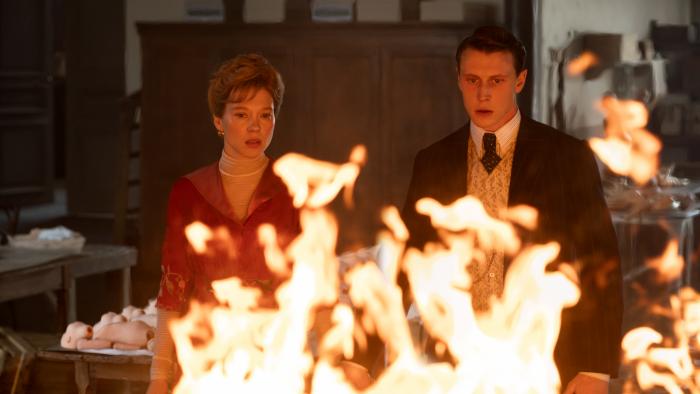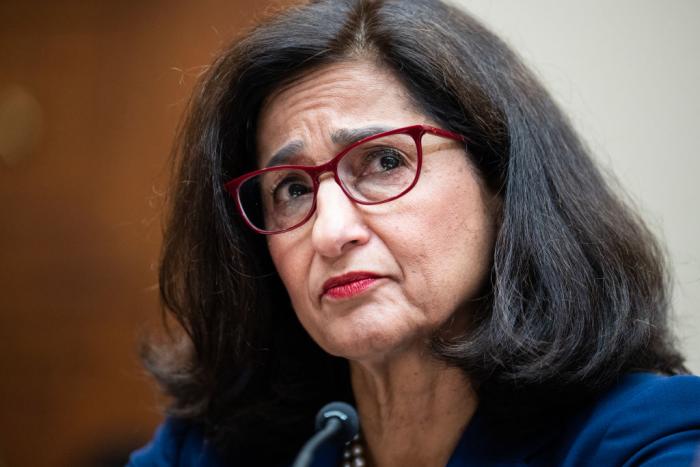

'The Beast' Is a Sweeping Romance Film Unlike Any Other
By Sara Clements | Film | April 25, 2024 |
By Sara Clements | Film | April 25, 2024 |

The Beast opens with Léa Seydoux walking into a room covered from top to bottom with a green screen. She’s asked to visualize a home, one where she is trapped. She’s anxious, conveying the feeling that something dark is creeping in. She grabs a knife as though she’s about to fend off an attacker. She screams.
This is a fascinating introduction to a film that’s an exercise in emotion. Here, and for the film’s remainder, you’re unsure if the actress is filming a movie within a movie. You’re also unsure if her emotions are real or a performance. Set in a near future where AI sees emotions as a threat and forces people to exterminate them, it’s not hard to find yourself questioning sincerity. But as the story unfolds, the film reveals itself to be a fight against a reality that may swallow us whole. It’s a weird sweeping romance and sci-fi dystopia mix that taps into so many contemporary anxieties, from AI stealing our jobs to climate disaster and the overall sense that the world is becoming unfeeling. It’s existential, yes, but it’s at its core a love story.
Bertrand Bonello adapts Henry James’ The Beast in the Jungle to create a story of fatal attraction, where two lovers connect and reconnect across time, all while walking towards a foreboding sense of doom. The film shifts between several periods, with three taking the most prominence. The first is Belle Époque-era Paris. A ballroom is the scene, and Louis (George MacKay) and Gabrielle (Seydoux, exuding a timeless and modern quality that’s a rarity) engage in a dance of intimacy. The intimacy in this case comes in the form of a secret. This is a reunion for the pair after an impactful meeting six years prior. For Louis, it was especially impossible to forget as Gabrielle confided in him her deepest, darkest feelings of dread. There was, and still is, a sense of doom lurking around her. She spoke of a beast that she believed would destroy everything in her life.
This “beast” is a metaphorical being that is mentioned throughout, and ties each timeline together. Another significant one is set in 2014, where the culture around dating gives you whiplash after spending time in 20th-century aristocratic Paris. It’s striking and also terrifying as toxic masculinity takes hold of Louis, while the toxic standards of beauty take hold of Gabrielle. This part of the film is quite jarring, as MacKay goes from dashing to disgusting, almost to an unrecognizable extent. Making Louis go from an aristocrat in one life to hating women in the next creates a disconnect from the character. Luckily, Bonello, along with co-writers, Guillaume Bréaud and Benjamin Charbit, make sure that aspects of each life the star-crossed lovers share mirror the other, creating a continuing sense of familiarity.
The film goes back to the titular beast often, creating a palpable sense of catastrophe. It could be interpreted as many things, but it all comes back to anxiety. The beast is fear. Fear of love. Fear of the future. Fear of everything. Jumping into a future timeline, AI wants to erase this fear. The year is 2044 and Gabrielle is being interviewed for a job, but the only way to get a job is to erase all emotion. It’s suggested that she look at her past lives and “clean” her DNA of all her old feelings, but she’s scared of no longer feeling. In this world, being numb gets you further. It’s almost unthinkable considering emotion is what drives us. How will we live without them?
The Beast tells this story of existential dread and romance in a way that is striking, both visually and in its writing. Images, once vibrant and alive in the past are later clinical in the future. The film becomes almost void of anything, as Gabrielle clings to what tears she has left to shed, encapsulating Seydoux’s brilliance in this role. This is in contrast to emotions depicted in the past that are juxtaposed with events of flood and fire. Feelings are vast and destructive, but that makes us human, after all. In all its weighty dialogue and ideas, the film’s message can seem muted and scenes confusing. However, it’s a playground ripe for interpretation. It’s an interpretation just as reliant on emotion as Gabrielle’s desire to continue in the past and the fear of spoiling the present. The “what ifs” of the past collide with the future.
Every piece of our humanity is under threat in The Beast. Admiring portrait canvases, Louis suggests that Gabrielle could be painted. “Never,” she responds. “I value my soul.” What would we be without one?
← Reddit Asks the Question: 'What Are Some Movie Lines That Make You Cringe?' | Jerrod Carmichael's Ugly Narcissism Is on Full Display in His HBO Reality Show →
More Like This
'Abigail' Is a Violent, Dancing Delight
Review: Look, You Knew ‘Back to Black’ Was Bad, BUT STILL!
Review: ‘Under the Bridge’ Is a Must-Watch True Crime Series That Gives the Victim a Voice
Review: ‘Sting’ is a Charming Creature Feature and What I Wanted from ‘Evil Dead Rise’
Review: Alex Garland's 'Civil War' Is A Scary Minefield of Apolitical Provocations

A Brief Report on American Education (It's Messy)
'Barbarian' Director Casts 'Ozark' And 'Fantastic Four' Star In His New Horror Movie
Watch John Krasinski And Steve Carell Reunite For New Movie
Ryan Gosling Knows Why ‘The Nice Guys’ Sequel Never Happened
Billie Eilish Thinks She Should Have 'A Ph.D In Masturbation'
The Original 'Blair Witch Project' Cast Fights For Their Rights And Royalties
More Like This
'Abigail' Is a Violent, Dancing Delight
Review: Look, You Knew ‘Back to Black’ Was Bad, BUT STILL!
Review: ‘Under the Bridge’ Is a Must-Watch True Crime Series That Gives the Victim a Voice
Review: ‘Sting’ is a Charming Creature Feature and What I Wanted from ‘Evil Dead Rise’
Review: Alex Garland's 'Civil War' Is A Scary Minefield of Apolitical Provocations
Reviews